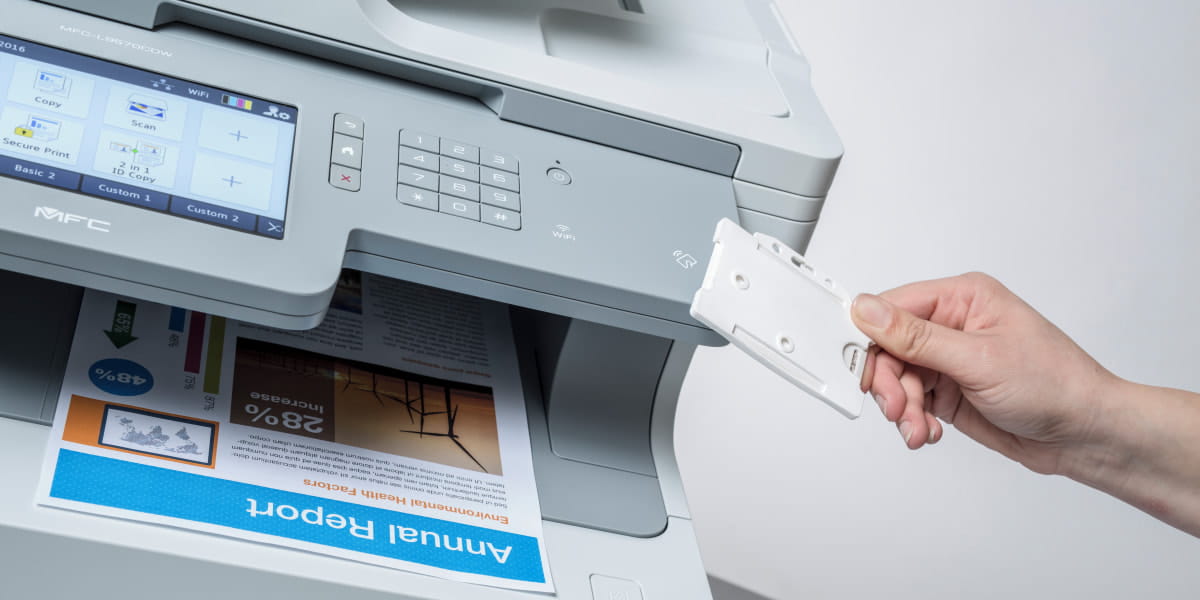Do you ever find yourself trying to do more with less?
As a business owner or IT manager, NFC technology may provide the solution you've been looking for. NFC stands for Near-Field Communication and has emerged as a handy tool for printing.
This convenient form of data transfer enables you to gain access to high-quality printed documents instantly - right from your mobile device or designated NFC card. But how, exactly, does this tech function?
In this blog post, we'll explore the meaning of NFC technology and how it relates specifically to printing. So, if you're interested in staying ahead of the game regarding printing trends, stick around.
What is Near-Field Communication (NFC)?
Near-Field Communication (NFC) is a wireless technology that enables two devices to communicate with each other when they're in close proximity. NFC is used in a variety of applications, including contactless payments, ticketing systems, and access control systems. It's also increasingly being used for printing purposes.
NFC chips, otherwise known as NFC tags, are now found in many smartphones, making it easier than ever to use contactless payments and transfer information quickly and securely. This technology is changing the way we interact with our devices and the world around us.
What are NFC tags used for?
NFC tags are becoming increasingly popular in today's technology-driven world. These tiny chips pack a powerful punch in terms of their capabilities, allowing for a range of applications. From mobile payments to security access and data transfer, businesses are leveraging the power of NFC tags to streamline their operations and improve overall efficiency.
By tapping into the power of NFC, businesses can create personalised workflows that enhance document security. For instance, law firms use NFC tags to ensure confidential documents such as contracts can only be accessed or printed by authorised personnel, while retailers use NFC tags to provide customers with relevant product information and offers.
Can you print via NFC?
Printing with NFC technology offers businesses a more efficient and secure way to manage their printing workflows. With NFC-enabled devices, printing can be accomplished with just a simple tap, eliminating the need for complicated printer set-ups and logins.
And while some may wonder if they can print with NFC, the reality is that more and more organisations in Australia are adopting this technology as a way to streamline their printing practices and increase overall productivity.
Not only does it offer a more seamless printing experience, but it also provides greater security measures to protect sensitive documents from falling into the wrong hands.
Read our comprehensive guide on how to navigate the world of document confidentiality
How do I print on my phone using NFC?
Print directly from your smartphone to select Brother printers with NFC technology. For instance, the Brother HL-9470CDN, a professional colour laser printer, has a built-in NFC reader. Simply choose the file you want to print from your phone or laptop, then hold your NFC-enabled device close to the printer. From here, you can release the print job and add it into the queue.
Types of printing supported by NFC
NFC can be used to print documents such as photos, text files, PDFs and more from both Android and iOS devices, as well as NFC cards. Additionally, some multi-function printers like Brother's MFC-L9570CDW feature an in-built NFC reader that supports smartphones and NFC cards for secure authentication or shortcuts for direct printing and scanning.
Benefits of using NFC for print workflows
Using NFC for printing offers several advantages over traditional methods of printing such as Wi-Fi or Bluetooth connections. For example, it requires less setup time and can be used to print directly from mobile devices without the need for additional software or hardware.
Additionally, it provides enhanced security since the data being printed is encrypted before it's sent wirelessly from one device to another.
In a nutshell, printing with NFC can provide the following five benefits to your office or business:
- Increased efficiency: By using NFC, printers can quickly and easily share data between devices, such as sending files from a computer to a printer or transferring job settings from one printer to another
- Improved security: NFC improves security by providing an encrypted connection between two devices so that sensitive information can’t be accessed by unauthorised users or malicious software programs
- Reduced waste: By using an NFC-enabled device, businesses can easily share digital versions of documents with others without having to print them out multiple times, saving both time and money in the process
- Enhanced user experience: Using NFC for print workflows can enhance the user experience by making it easier for users to find and access documents quickly and efficiently
- Cost savings: Businesses can save money on printing costs due to its ability to reduce paper usage as well as its increased efficiency in managing print jobs
What is Pull Printing?
Have you ever printed a document and then rushed to grab it before someone else could get a glimpse of its contents? With Pull Printing, those worries are eliminated. By using authentication codes or NFC tags and cards, documents are securely released only to the rightful owner.
And with select Brother colour laser and monochrome laser printers, the process is made even simpler thanks to large intuitive touchscreens and NFC Tap to Release printing with ID cards or smartphones. Pull Printing removes the stress of confidential information sitting on top of a printer for anyone to see.
For more information on Pull Printing, read our page on Print Management
Utilising NFC technology with Brother
NFC is a powerful technology that has revolutionised many aspects of our lives - including how we print documents from our mobile devices. By leveraging this technology, users can quickly and securely print documents without having to worry about complicated setup processes or compatibility issues between their printer and mobile device.
If your business is looking for an all-encompassing solution to its print and document workflows, a Brother Managed Print Services (MPS) solution could be the answer.
Brother offer a range of NFC-enabled printers and multi-function devices that provide a secure and efficient way of printing, scanning and copying documents, ensuring the protection of your sensitive data.
With industry-leading software bundled with a Brother MPS solution, your organisation can easily manage and optimise printing workflows, leading to reduced waste and improved data security. By adding that extra layer of protection with NFC, you and your staff will ensure business-critical documents end up in the right hands.
Take our interactive MPS quiz to see if it’s a right fit for your business, or speak to one of our experts at Brother today and discuss a print solution that suits your needs.
FAQs about NFC
If you're unfamiliar with how NFC works or what it can do, you're not alone. Here are the most frequently asked questions about NFC to help you better understand this innovative technology.
How does NFC work?
NFC works by using electromagnetic fields to transmit data between two devices. When an NFC-enabled device comes into proximity with another NFC-enabled device, the two devices can exchange data or perform certain tasks such as making a payment or printing a document. The process is fast and secure, as the data is encrypted before it is transmitted.
Compatibility requirements to print with NFC
To use an NFC connection for printing, both the printer and mobile device must support this feature. Many Brother devices like the professional monochrome laser MFC-L6900DW have built-in support for NFC while most newer smartphones and tablets also feature this technology built-in as well; however older models may not be compatible with NFC.
That's why it’s worth checking your device's specifications before attempting to use an NFC connection for printing purposes.
How secure is NFC printing?
The good news is that printing via NFC is just as secure as any other method - all data exchanged between two devices is encrypted so there's no risk of anyone intercepting sensitive information while it's being transferred over the airwaves.
Additionally, many Brother printers have built-in security features such as password protection which will help keep your documents safe from unauthorised access. At Brother, our NFC-enabled printers and all-in-one devices can be configured to only allow certain users to access printing, scanning or copying workflows, while IT managers and business owners are given wider permissions to operate certain functions.
Are there any disadvantages of printing with NFC?
Since data is transferred wirelessly over short distances using NFC, there may be some security concerns depending on the type of information being printed out.
However, with Brother's Secure Print feature, available on select Brother print devices, users can send documents directly to the device without worrying about unauthorised access. Documents will only be printed when the user enters a personal PIN number on the machine.
Do all phones have NFC?
Unfortunately, not all smartphone brands and types have NFC technology enabled. While many of the newer phone models from Apple, Samsung, and other major brands come equipped with NFC, some budget or older devices may not support this feature.
It's essential to check the specifications before buying a new smartphone if you need NFC for regular use. However, as technology continues to advance, there's bound to be more and more smartphones with NFC capabilities in the future.
Is NFC a Bluetooth technology?
Despite sharing some similarities, NFC is not a Bluetooth technology. NFC stands for Near-Field Communication, and it is a short-range wireless communication technology that enables devices to exchange data by simply touching them together. Unlike Bluetooth, which has a range of 10 metres or more, NFC is only effective up to a maximum distance of about 10 centimetres.
NFC's strength lies in its convenience and security, as it requires both devices to be in close proximity to establish a connection. This technology is commonly used in contactless payment systems, transportation ticketing and smartphone connectivity. While NFC and Bluetooth are wireless communication technologies, they serve different purposes and have different applications.
RFID vs NFC: What's the difference?
RFID and NFC - two acronyms that are often confused with each other. Both of these wireless communication technologies are used to transfer data between two devices, but they differ in functionality and usage. In short, while RFID is primarily designed for long-range communication, NFC is focused on short-range connectivity.
RFID technology is used for tracking and identifying objects, whereas NFC enables mobile payment services and contactless transactions. The main difference between the two is that RFID requires a dedicated reader, while NFC can be used with a smartphone and enabled with a simple tap.



